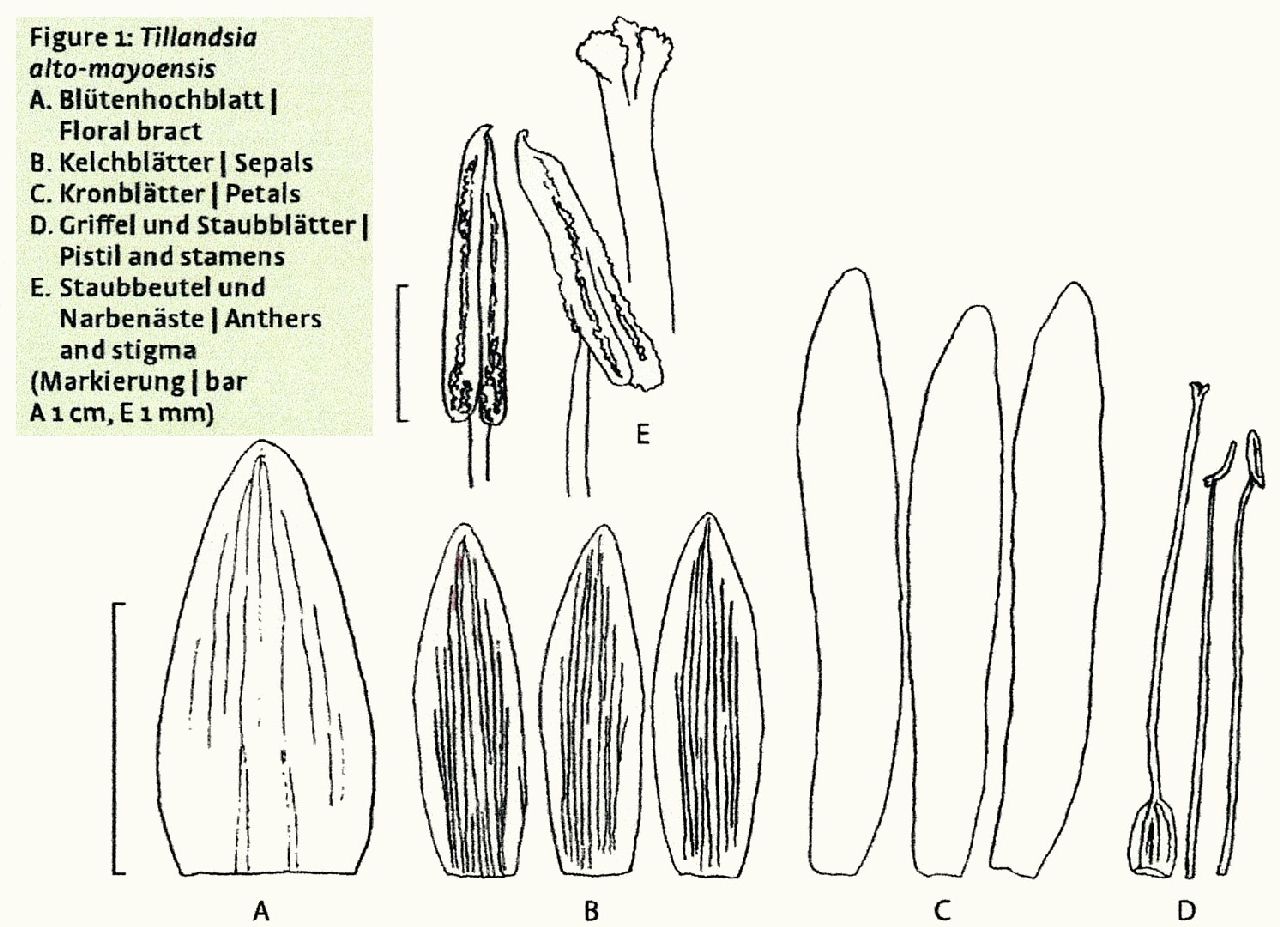


In the 2016 World Bromeliad Conference in Texas USA, Jerry Raack showed this unknown Tillandsia in the Bromeliad show. The plant came from Karol Villena, Orquidias Amazonicas, Moyobamba, Peru, sold under the name Tillandsia confinis, which of course is not anything like it. The plant was collected south of Moyobamba half way between Santa Isabel and Jepelacio at about 1400 m elevation.
This new species is closely related to Tillandsia rusbyi Baker (1889) or, if different, Tillandsia ulei Mez (1905). Interestingly, the description of T. ulei given by Mez, seems to be a translation of the English description given for T. rusbyi by Baker into Latin, with some omissions and a few changes. The main differences are the length of the floral bracts (7 mm vs. 1012 mm), lepidote and nerved in Bakers description and not mentioned by Mez, sepals equally subfree, glabrous, the adaxial ones carinate in T. rusbyi and again omitted by Mez. Then Mez added some details for the pistil, not given by Baker. This is not very helpful in distinguishing the two species, because only the difference in floral bract length remains. I think that this was the reason for Lyman B. Smith (Smith & Downs 1977) to consider T. ulei a synonym of T. rusbyi.
More study is needed to reveal all the differences between those two species, but it is clear that they are not conspecific and both species need recognition.
Here, this new species is only compared with Tillandsia rusbyi because it comes closer in floral bract length and has a more detailed description. Jerry sent me nice photos of the flower details, which started the discussion what species it could possibly be.
Later Jeffrey Kent sent me a flowering plant that came through the flight very nicely and kept on flowering and was used to prepare the description and type specimen voucher.
Description
Plant acaulescent, flowering 25 cm tall, subdense, with many leaves, forming a crateriform rosette.
Leaves spirally arranged, thin coriaceous, 15.518 cm long, curving and hence exceeded by the inflorescence.
Sheaths large, contrasting with the blade in color and contracted into the blade, ovate, slightly convex, 45 cm long, 3.13.3 cm wide, with thin margins especially toward the base and purplish toward distal end, densely lepidote on both sides, with subappressed, ferrugineous and dark centered scales adaxially in upper part, sheath color pale to dark brown in upper part.
Blades arching to recurving, soft, thin coriaceous, channelled to involute when dry, very narrowly triangular, 1214 cm long, ca. 1.5 cm wide, attenuate, acute, densely lepidote, less lepidote on upperside, with subappressed, cinereous scales, cinereous-green especially abaxially.
Inflorescence bending over, sub-digitately compound of 712 spirally arranged branches, ca. 22 cm long, fertile part 1215 cm long, subdense, the lower branches often more remote, the upper sub-digitate.
Peduncle short, wholly covered by bracts, curved, ca. 8 cm long, 45.5 mm in diam., glabrous, cream colored.
Peduncle-bracts sheathing part clasping the peduncle and erect with divergent blades, densely imbricate, all foliaceous, thin and soft coriaceous with chartaceous sheath, narrowly triangular or the upper ones with setaceous blade, attenuately acute, all much exceeding the peduncle, densely lepidote like the leaves, cinereous-green.
Axis completely hidden by bracts and the branches, stout, nearly straight, excaved and angled along the base of the branches, glabrous, pale green.
Primary bracts suberect, imbricate, chartaceous, ovate or elliptic, ca. 2 cm long excluding cusp, cuspidate to acuminate in the upper ones, about equalling the stipe of the branches or the lower exceeding it by the setaceous blade, densely lepidote, greenish to orange in upper ones.
Stipe prominent, ca. 3.5 cm long, the basal 2 cm erect and contiguous with the axis, not bracteate, the upper divergent part with a few bracts, slender, slightly complanate and bi-carinate distally, glabrous, pale green.
Stipe bracts erect (contiguous), densely imbricate, coriaceous, like the floral bracts but smaller (12 mm), ovate and the lower one bi-carinate, the other(s) carinate.
Spikes divergent, very dense, distichous, 1216 flowered, strongly complanate and flat, lanceolate with long cuneate base, acute, excluding stipe 67 cm long, 1011 mm wide, with a few smaller sterile bracts at base and apex.
Rachis hidden, stout, slightly flexuous, sharply 4-angled (excaved), the internodes 23 mm long, glabrous, cream colored.
Floral bracts suberect, very densely imbricate, stiff-coriaceous, slighly veined, bicarinate at the base and bluntly to obscurely carinate in upper half, ovate, narrowly rounded or obtuse, incurved in upper half, 1.6 cm long, 0.8 cm wide, many times as long as the internodes, about as long as the sepals, with narrow hyaline margins, abaxially glabrous at both sides, orange to red.
Flowers contiguous (erect), 2.6 cm long.
Receptacle short, obconic, 1 Χ 2 mm.
Sepals chartaceous, surface nerved, narrowly ovate, obtuse, nearly straight, 1313.5 mm long, 3.8 mm wide, adaxial and abaxial ones all alike and ecarinate, for adaxial ones 1 mm fused, glabrous, hyaline to white.
Corolla tubular-erect to slightly divergent.
Petals lingulate, narrowly rounded or obtuse, 2122 mm long, 3.2 mm wide, free from each other, white, without ligules at the petal-claw, with irregular denticulate margins.
Stamens included.
Filaments fleshy and complanate, linear, straight (not plicate), all equal in length.
Anthers dorsifixed, at about one forth from base, 1.52 mm long, bi-lobed at base, apiculate at the apex.
Pistil exceeded by the stamens.
Ovary ellipsoid, 3 mm long, 2 mm wide, abruptly contracted into the style, superior.
Style elongate, many times as long as the ovary, slender, white.
Stigmas erect-conduplicate, short.
Etymology
The plant is named after the area Alto Mayo, where it was found.
Distribution
Only known from the type locality, Peru, San Martin.
Observations
The erodate denticulate petal margins and inflorescence type as well as the rosette shape and indumentum also suggest that this new species is closely related to the much taller and blue flowering Tillandsia appenii (Rauh 1969) J. R. Grant (2004). Although it lacks any petal appendages, it does belong to the subgenus Pseudovriesea Barfuss & W. Till (2016).